Among many of the challenges a farrier must deal with are sheared heels. Scott Morrison, the veterinarian and farrier who leads the Podiatry Department at Rood & Riddle Equine Hospital, Lexington, Ky., says this problem is usually the result of less than ideal conformation. Usually the horse toes in or out, putting more stress on one side of the hoof wall (and heel) than the other. When a horse develops sheared heels, the stressed heel becomes jammed upward, the hoof symmetry is distorted and one heel is bearing most of the weight.
The clinical definition of sheared heels according to “Podiatry Terminology,” a glossary originally published in Equine Veterinary Education, and reprinted in the November 2007 issue of American Farriers Journal, is a “Displacement of one heel bulb proximally relative to the adjacent heel bulb. Thought to result from abnormal loading on one side of the foot.”
Julie Bullock, DVM, a podiatrist in Mt. Sidney, Va., says she often sees sheared heels on horses with an extreme toe-in or toe-out conformation or abnormal landing patterns. The horse that lands harder on one side of the foot than the other will eventually develop sheared heels.
“It’s not just how the foot is landing while in motion,” she explains. “As that imbalance starts becoming more pronounced, then the static balance is also distorted and will contribute to the problem. Injuries can also create sheared heels.”
The earlier you catch it and deal with it, the better. If there’s too much stress on any one part of the foot, certain structures suffer more stress and trauma. To stay sound, the hoof needs to bear weight properly, with various structures sharing the load.
According to Steve Norman, a farrier from Midway, Ky., who shoes a lot of racehorses, sheared heels are very common in running horses.
He says the problem often starts at an early age due to conformation. You can sometimes see the process starting by the time the foal is a weanling, says Norman.
“It’s important to see the early signs in order to correct it. Otherwise the problem may eventually become so overwhelming you can’t fully correct it — and all you can do then is just try to keep it from getting worse,” he says.
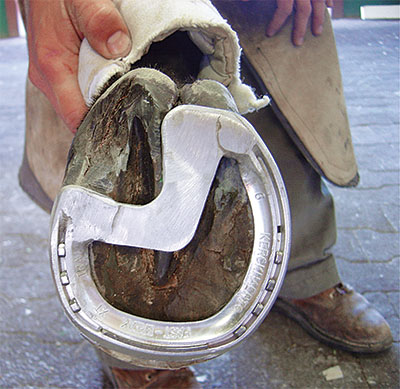
Farrier Steve Norman uses the Z-bar shoe in many cases of sheared heels. The shoe allows the sheared heel to float and transfers weight to the frog and the stronger heel.
Norman says the majority of cases he sees occur in foals that toe out, putting too much pressure on the inside quarter of the foot.
“As the young horse is running and growing, there’s more pressure shoving that heel up,” he says. “That’s why the horse has a straight wall on the inside of the foot and a flared wall on the outside. If the early signs aren’t dealt with by the time the horse is a yearling, it gets worse after that horse goes into training.”
Norman says the addition of weight on the horse’s back as well as added speed means more pressure and stress.
“Soon we are dealing with sheared heals and quarter cracks — because when the digital cushion becomes compressed on one side or the other, it hinders the natural shock absorption in the back part of the heel and there’s even more concussion in that area,” Norman continues. “It’s a vicious circle, especially if the horse is a runner.”
He says a horse that isn’t racing, with less stress on the foot, may recover more easily with proper footcare and shoeing.
Other Heel Problems
“Sheared heels are interesting, and some of them are related to contracted heels,” says Morrison. “Most sheared heels are like a unilateral contracture (on just one side). A normal foot should have a nice shape with sloping hoof walls. If you look at sheared heels, most of the time it’s the medial (inside) heel. That wall does not have a nice slope; it becomes quite vertical and straight,” he says. The foot is too vertical on the inside wall and may be flared out on the outside wall.
“As the one heel gets more and more contracted and that wall becomes vertical, it begins to be displaced upward. My theory on sheared heels is that first of all, the part of the foot that’s under the most vertical load tends to develop a straight wall.
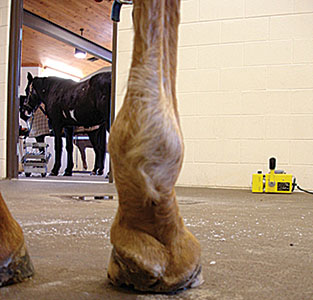
Veterinarian Scott Morrison warns against using the coronary band to guide trimming in sheared heel cases. He has seen many cases in which the coronary band is pushed up on one side, but radiographs show that the distal phalanx is actually tipped lower on the same side. Trimming that side to make the coronary band parallel to the ground would actually result in tipping the third phalanx even more.
“The side with a more horizontal load develops a flare. I see a lot of normal horses get more of a straight medial wall and more flared lateral wall, but when this becomes more exaggerated — a larger outside flare and a more vertical inside wall, with more hoof capsule distortion — the inside heel becomes aligned directly beneath the bony column (the vertical line of force) and gets pushed upward, creating the sheared heel.”
Let Radiographs Be Your Guide
“It is very important to radiograph those feet for balance. If you are dealing with a horse with sheared heels, I recommend having a veterinarian radiograph it,” Morrison says.
Bullock agrees.
“A lateral and a dorsal-palmar X-ray are critical because you really need to see where the coffin bone is, in relation to the hoof capsule,” she explains. “That bone will start to tip one way or the other and drop.”
Trimming Methods
“There are a couple common ways to deal with sheared heels. Some people trim the sheared heel side lower, and some people trim the opposite side lower,” Morrison says. “These who try to trim the sheared heel lower are trying to match wall length, since the inside wall is shoved upward and if you measure the actual length of the wall it is longer, while the outside (flared side) is actually shorter. The same school of thought looks at the coronary band and tries to trim the hoof so that the coronary band will be parallel to the ground,” he says.
“But when I radiograph these sheared heels, I find that trimming them this way is probably the opposite of what you want. The radiographs show that the coffin bone is tipped lower on the medial side. The length of wall and alignment of coronary band really can’t be used as guides for trimming (with sheared heels) because it’s distorted and this type of trimming may be adding more stress. If you trim that side lower you may be tipping the coffin bone even lower on that side.”
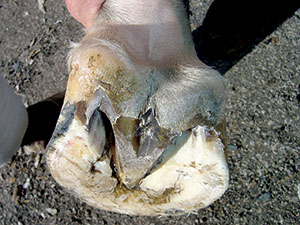
Abnormal loading on one side of the foot is believed to cause sheared heels, in which one heel bulb is displaced proximally to the other.
Bullock feels it’s always a good idea to take X-rays so you can follow up and see if what you are doing is actually changing the location of the coffin bone.
“The hoof capsule will mimic the position of the bone. We don’t really know which comes first,” she asks. “Is the hoof capsule following the shift of the bone or is the position of the bone being driven and determined by the hoof capsule?”
She warns that a farrier can get into trouble by just treating the hoof capsule shape without taking into account what’s inside.
“When you look at a sheared heel you must try to determine why it’s being sheared,” she says. “Is it because the horse has a painful lesion that’s causing him to load one side more than the other?”
Radiographs, she says, can help determine if there is a lameness issue causing the horse’s abnormal loading. Rather than a conformation issue, the horse may be simply trying to stay off the painful side of the foot.
Quarter Cracks
“Often a horse with sheared heels will also have a quarter crack, due to the stress on the hoof wall,” says Morrison. These problems seem to go hand-in-hand, when one side of the foot is overloaded.
Norman says when sheared heels are not dealt with soon enough, the inflammation and trauma becomes worse and the laminae may start tearing and hemorrhaging.
“If the laminae tear, the quarter crack blows out. The crack has already been forming inside the laminae. We call this a blind quarter crack because it hasn’t surfaced yet,” says Norman.
Special Shoes
Bullock explains that you have to address the heel that’s being pushed up. “It must be floated to where it’s not taking weight, so it will drop back down. But you have to support the hoof capsule while that’s happening,” she says.
Morrison says that if it’s a severe case of sheared heels, he’ll often make a bar shoe or heart bar shoe and float that side so it isn’t bearing weight.
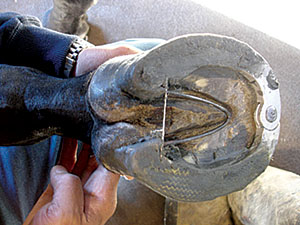
Scott Morrison has used this spring shoe to help open up a sheared heel on the medial side of the horse when the heel has become particularly upright. The shoe helps redirect the vertical line of force and gives the hoof capsule a better shape.
“I’ve had some that were so sheared and overloaded that the wall was separated and undermined. Some of these actually need to be resected. Usually these will heal nicely. The most important thing is rebalancing the foot, using radiographs to guide you in getting the foot trimmed properly,” he says.
“If the medial heel starts to shear, it first becomes more vertical, looking almost like half a contracted foot. We’ve actually made a spring shoe to address this, opening up just half the hoof — just the one side — to get it away from the vertical line of force and get a better shape to it. The spring shoe has a hinge in the toe and a spring at the end of the heel branch. We usually glue the shoe under the horse’s foot and put the spring into the shoe.
“If you move that inside contracted heel out to where it should be, it drops as well. If it’s been shoved up and sheared, it actually drops down and relaxes when you get it pushed back out, getting that medial wall away from that vertical line of force. The spring shoe can work well for this.”
There are multiple ways to deal with sheared heels, depending on what caused them, whether it’s floating that heel or using a shoe with a hinge and a spring to push that heel and contracted wall out again, or just having the horse go barefoot. (See “Barefoot Approach May Help With Sheared Heels,” on Page 69).
Reoccurring Problem
“Once you get them corrected and the heel dropped back down where it should be, you have to remember that you haven’t really changed the horse’s conformation and he will always be predisposed to displacing that heel again. I always give these horses some type of support over their frog if they have to be shod, either with a heart bar shoe or one with a plate across the heel to support it. You want to distribute that load over the frog and more structures of the heel,” Morrison says. “You need to relieve the stress over the side that’s been getting too much.”
Norman says that sheared heels are probably one of the worst breakdowns for racehorse so far as trying to keep the horse in training.
“When that quarter and heel become inflamed, the horse starts limping, and you have to try to support the foot to relieve the pressure. Mechanically, it’s a little tough to do this and still keep the horse racing,” explains Norman.
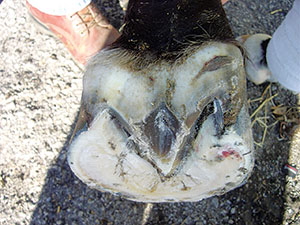
Sheared heels are often seen in horses with a conformation in which the hoof turns outward. A hairline that stands up over the heel bulbs can also be an early warning sigh of sheared heels.
The shoe he generally uses is a Z-bar shoe — a bar shoe in the shape of a Z that distributes weight to the good heel and the frog, rather than the sheared heel.
“It’s like half of a heart bar shoe. You basically cut the shoe off at the widest part of the foot, where the sheared heel is,” he explains. “Then the bar of the shoe runs straight across to the tip of the frog. An aluminum bar running up the frog connects to the good heel and supports the good half of the foot, leaving the damaged heel floating so it’s not taking any weight,” says Norman.
On a sheared heel, the horn tubules in the hoof wall are bent.
“Getting the weight off that heel will take the pressure off those distorted tubules to where they can relax and straighten again,” says Norman. “You can see the heel come back down, with this pressure off, reducing the concussion and inflammation and reducing the pain.”
Radiograph-Guided Grooving
Bullock says some farriers also try grooving the hoof wall along the sheared side, to encourage more flexibility. The grooving tends to weaken and change the alignment of the horn tubules, allowing that heel to drop and spread even more. If digital X-rays are being taken, this method (and any progress made while using it) can be readily evaluated.
“Grooving the side that’s pushed up may resolve a sheared heel if the horse has a slightly pushed up coronary band,” says Bullock. “This method is also tried for quarter cracks, to help spread the stresses on that part of the hoof wall. We don’t know all the dynamics that are going on, but sometimes grooving is worth a try. Sometimes it’s a case of nothing ventured, nothing gained.”
Keep After It
“After you get the sheared heels corrected it’s very important to keep up with the trimming program and stay with a shoe that provides some type of support over the frog or base of the frog to share the load,” says Morrison. “Several horses I’ve fixed sheared heels on and sent home have come back less than a year later with the heel sheared right back up again — with the horse in a normal shoe.”
If a horse has seriously sheared heels, it may be a situation where all you can do is support and maintain the foot because its conformation will always put extra pressure on one heel. That horse needs careful trimming and shoeing for the rest of its life.
“The conformation that leads to sheared heels is usually one with feet that turn out a little bit (splay footed),” says Morrison. “There are also some horses that don’t have the hoof and pastern in a straight line. If you look at them from the front, it looks like the hoof is offset to the outside. Those feet tend to develop really bad sheared heels.”
Farrier Steve Norman uses the Z-bar shoe in many cases of sheared heels. The shoe allows the sheared heel to float and transfers weight to the frog and the stronger heel.








Post a comment
Report Abusive Comment